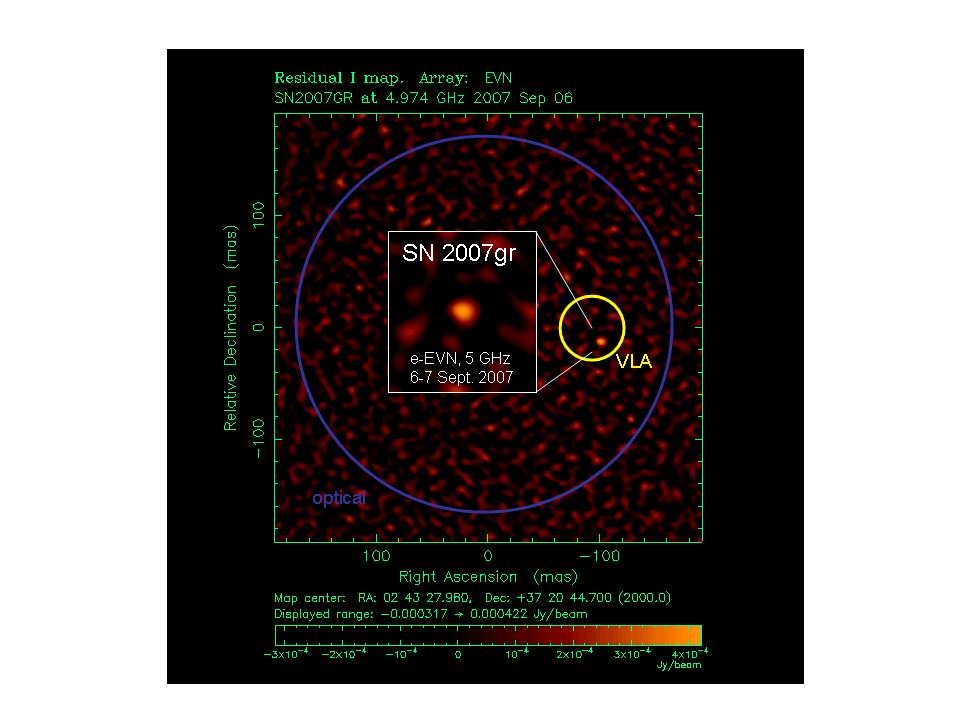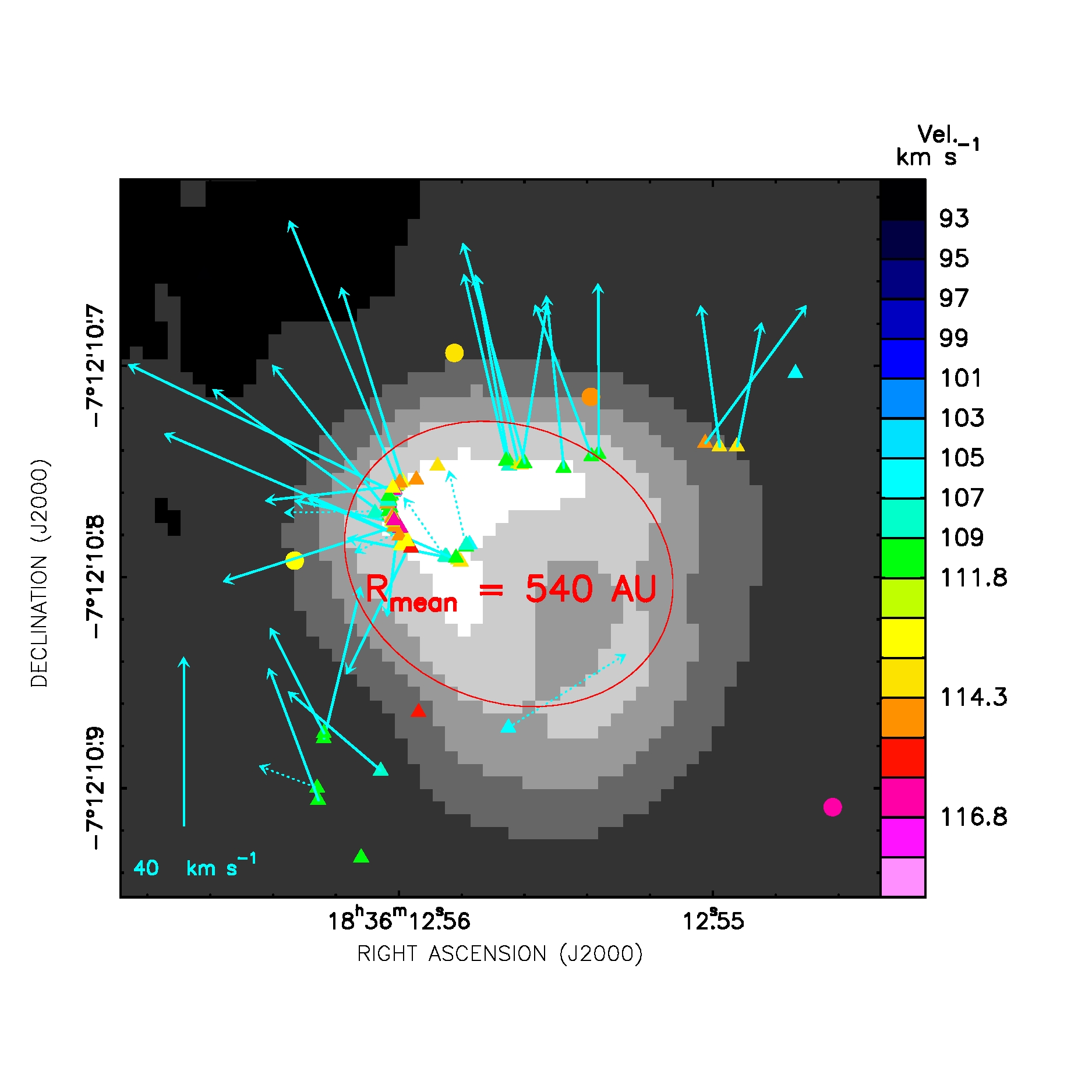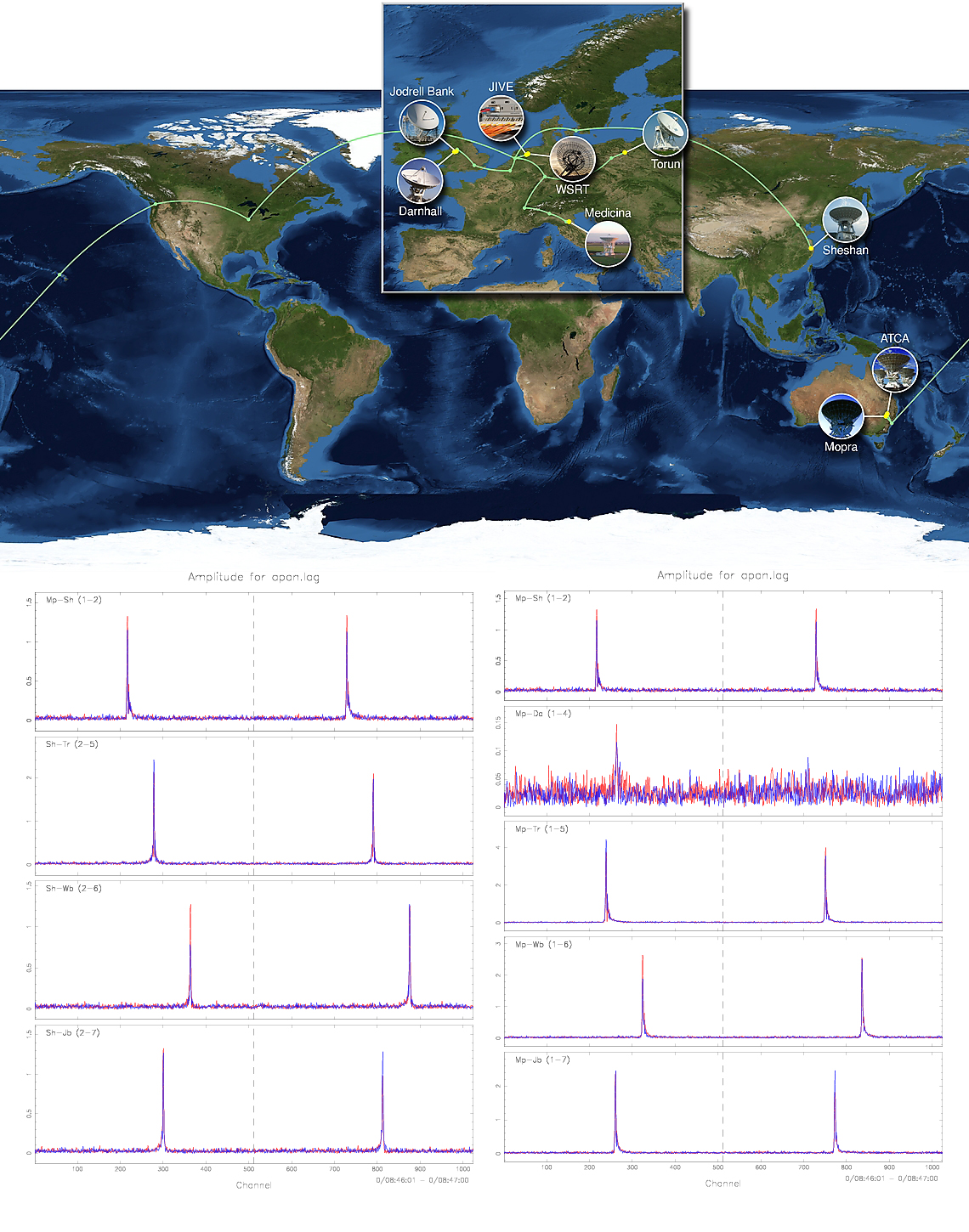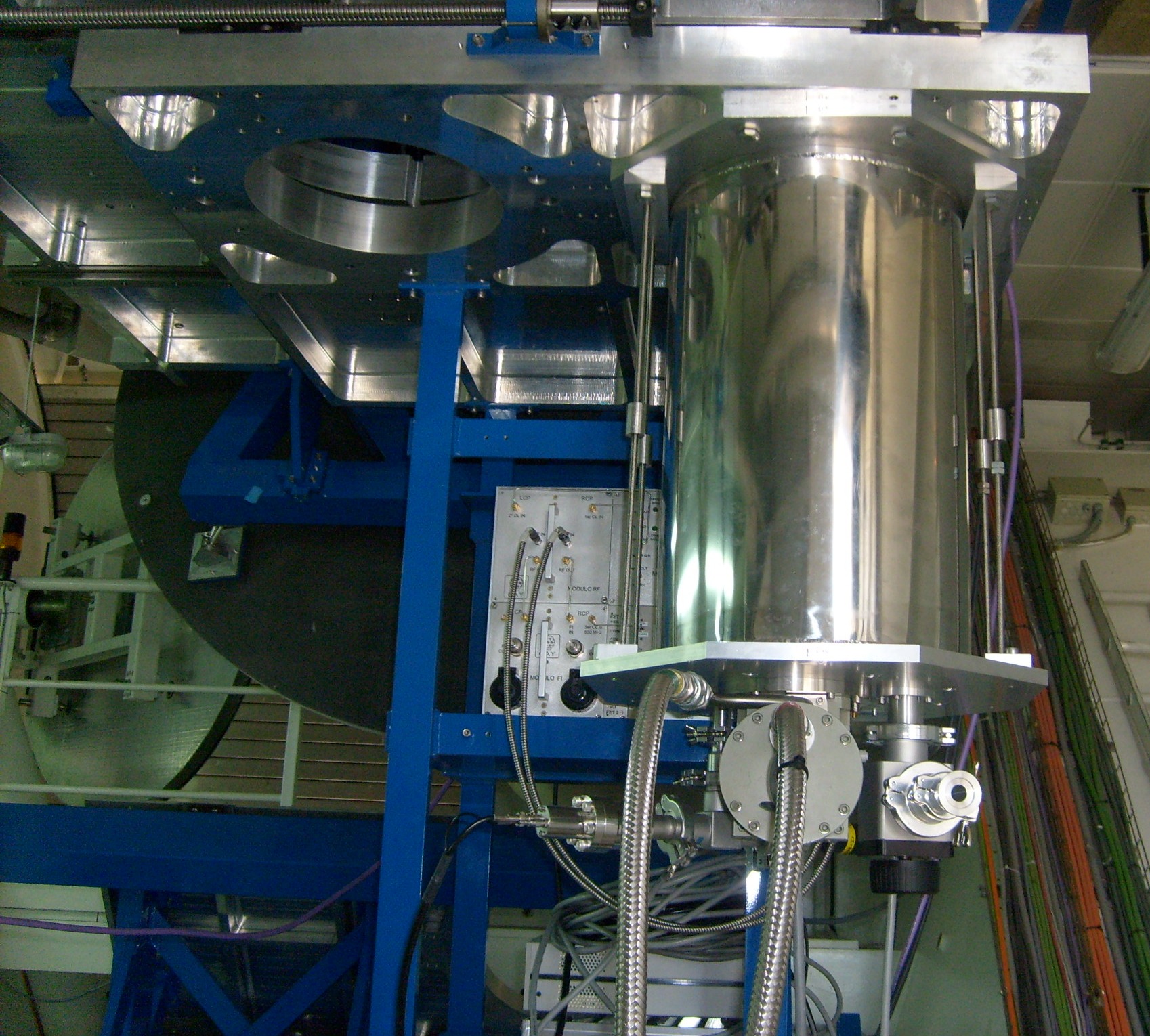|
|
European VLBI
Network Newsletter |
|
Contents |
|
|
|
1. Call for Proposals - Deadline 1
October 2007
ALL
EVN and GLOBAL PROPOSALS must now be submitted
with the ONLINE PROPOSAL SUBMISSION tool
Northstar.
Email submission is no
longer accepted
Observing
proposals are invited for the EVN, a VLBI network
of radio telescopes spread throughout
The EVN
is open to all astronomers. Use of the Network by astronomers not specialised
in the VLBI technique is encouraged.
The Joint Institute for VLBI in Europe (JIVE) can provide support and advice on project
preparation, scheduling, correlation and analysis.
EVN Observing Sessions in
2007-2008
|
2007 Session 3 |
Oct 18 - Nov 08 |
18/21cm, 5cm, S/X, 7mm |
|
2008 Session 1 |
Feb 28 - Mar 20 |
18/21cm, 5cm, S/X, +... |
|
2008 Session 2 |
May 29 – Jun 19 |
6cm, 7mm, +... |
Proposals
received by 1 October 2007 will be considered for scheduling in Session 1, 2008
or later. Finalisation of the planned observing wavelengths will depend on
proposal pressure. Other wavelengths which may be scheduled in 2008 are 90cm,
50cm, 30cm, and 1.3cm.
Special features for Sessions in 2008
·
Observing time during additional short 24-hour e-VLBI
runs in November, December 2007 and January, February 2008 is also be
available. See the e-VLBI
Call for Proposals at http://www.evlbi.org/evlbi/call_evlbi.html for
details.
·
MERLIN is available for joint EVN+MERLIN observations
in all sessions, for any EVN wavelengths which MERLIN supports (18/21cm, 6/5cm,
1.3cm). However, limited resources during e-MERLIN construction mean that joint
EVN+MERLIN will be scheduled at no more than two of these bands (usually
18/21cm and 5/6cm) in any one session.
·
Recording at 1 Gb/s (Mark 5A) is now possible for an
increasing number of projects. It is planned that this will become soon the
standard observing mode for all continuum EVN-only projects.
Large projects
Most
proposals request 12-48hrs observing time. The EVN Program Committee (PC) also
encourages larger projects (>48 hrs); these will be subject to more detailed
scrutiny, and the EVN PC may, in some cases, attach conditions on the release
of the data.
How to submit
The on-line proposal submission tool
Northstar now replaces the old Latex-email way of submission for all EVN and
Global proposals; EMAIL PROPOSAL SUBMISSION IS NOT POSSIBLE ANYMORE. Global
proposals will be forwarded to NRAO automatically and do not need to be
submitted to NRAO separately.
To use
Northstar, people should register (only for the first proposal submission),
enter the information about the investigators and the technical specifications
of the proposed observations (equivalent to that previously in the coversheet)
using the on-line forms, and upload a scientific justification in pdf or ps
format. The scientific justification should be limited to 2 pages in length. Up
to 2 additional pages with diagrams may be included. The deadline for
submission is 23:59:59 UTC on 1 October 2007.
Additional information
The detailed Call for Proposals (http://www.obs.u-bordeaux1.fr/vlbi/EVN/call-long.html)
has further information on Global VLBI, EVN+MERLIN and guidelines for proposal
submission.
The EVN User Guide (http://www.evlbi.org/user_guide/user_guide.html)
describes the network and provides general information on its capabilities.
The EVN Status Table (http://www.mpifr-bonn.mpg.de/EVN/EVNstatus.txt) gives current
antenna capabilities.
The On-line VLBI catalogue (http://db.ira.inaf.it/evn/)
lists sources observed by the EVN and Global VLBI.
Patrick
Charlot - Chairman of the EVN Program Committee
2. Call for
EVN e-VLBI science proposals - Deadline 1 October 2007
Proposals
for EVN eVLBI observations on pre-scheduled dates in late 2007/early 2008
are invited for submission for the Oct 1st EVN deadline. New
features and possibilities for eVLBI observing include
the following.
·
Based on recent tests (see http://www.expres-eu.org/512Mbps_6tel.html) it is expected
that a 512Mbit/s bit rate can be achieved.
·
A special 'double header' observation is scheduled for
January 2008, with two eVLBI runs three days apart in which the schedule for
the second run can be changed based on the results of the first run.
·
A new class of 'triggered' e-VLBI proposal is now
defined in which a pre-approved project can be activated up to 24 hours before
a scheduled eVLBI run based on a trigger criterion being met. In addition other
'standard' eVLBI proposals are no longer restricted to rapid response
science.
·
Spectral line observations are now supported.
·
1.3cm band observations can now be proposed for.
Scheduled
e-VLBI runs for which observations can be proposed for the October 1st EVN
deadline are;
|
Run start |
Run end |
|
Thur 15 Nov
13:00 UTC |
Fri 16 Nov 13:00 UTC |
|
Tue 11
Dec 13:00 UTC |
Wed 12 Dec
13:00 UTC |
|
Mon 21
Jan 13:00 UTC* |
Tue 22 Jan
13:00 UTC* |
|
Thur 24 Jan
13:00 UTC* |
Fri 25 Jan
13:00 UTC* |
|
Tue 5
Feb 13:00 UTC* |
Wed 6
Feb 13:00 UTC* |
(Note *
indicates a provisional date to be confirmed). Participating EVN antennas
are the following seven stations, Wb14 (tied array, except 5cm),
Tr, On85, Mh, Mc, Jb2 and Cm. Wavelength bands
covered are 18/21cm, 6cm, 5cm and 1.3cm. Please
see http://www.evlbi.org/evlbi/e-vlbi_status.html for the
availability of different eVLBI stations per observing band. Note that
because of on-going engineering work participation of Jb2 and
Cm cannot be guaranteed and/or they may be replaced by other
MERLIN telescopes.
NOTE
That the sessions in early 2008 are scheduled close together and proposals
making creative use of these runs are highly encouraged. In particular it
will be possible to use the two runs in January for 'adaptive observing'
where the schedule for the second run is changed in response to the
results of the first run. For such an adaptive observation the PIs
will be expected to visit JIVE for the observations. Note
however that the January sessions are not exclusively reserved for
observations in this adaptive mode and other types of proposals are also
encouraged.
TECHNICAL
DETAILS
CONTINUUM
OBSERVATIONS - will be run at the highest possible reliable bit rate. Based on
recent experience it is expected that 512 Mbit/s is very likely to
be achieved and 256 Mbit/s virtually certain (however Cm is
presently limited to 128 Mbit/s of useful data by its microwave
link). Continuum observations can be proposed for only one of the bands
18, 6 and 1.3cm in any given 24hr session.
SPECTRAL
LINE OBSERVATIONS - can be carried out at recording rates between a
minimum of 32 Mbit/s and a maximum of 512Mbit/s. For
two-bit, dual-polarisation observations, the lower limit implies at
least 4 channels of 4 Msample/sec sampling (Nyquist channel bandwidth =
2MHz; with oversampling possible down to spanned channel bandwidths of
0.5MHz). Observations may be proposed for the 18cm/21cm, 5cm and 1cm
bands. Note that only standard and short observation proposal types
(see below for definitions) are allowed for spectral line
observations. Triggered spectral line proposals will not be
accepted.
e-VLBI
OBSERVATION CLASSES
The new
eVLBI submission policy defines three classes of EVN eVLBI observation.
Time within the first two classes will only be allocated
in response to proposals submitted for the standard EVN proposal
deadlines of 1st Feb, 1st June and 1st Oct. PI's should make
clear in the proposal text which class of observation is
being requested.
1)
Standard e-VLBI proposals
Any
proposal requesting e-VLBI observing time during one or several e-VLBI
sessions, excluding triggered response science. Such proposals may also
request observing time during regular EVN sessions using disk recording.
Monitoring proposals may be submitted but observations cannot be
guaranteed in every requested session as they may be overridden by
higher rated, triggered e-VLBI proposals. Standard proposals can be
either continuum or spectral line. Scheduling will be done by JIVE
staff using the technical information included in the proposal; it
is therefore vital that all technical aspects are fully specified in the
proposal.
2)
Triggered e-VLBI proposals
A
proposal to be scheduled during an e-VLBI run only if a
specific triggering criterion is met. Accurate source coordinates need only
be included in the trigger request, not the original proposal.
Only continuum observations can be proposed for within this
class. Triggered proposals must include a precise and
justified triggering criterion and a minimum number and
configuration of telescopes required.
PIs of
successful proposals in this class will be informed after proposal review
that their trigger requests will be accepted. Such trigger requests should
be sent by e-mail to the EVN PC Chair (Patrick Charlot <charlot@obs.u-bordeaux1.fr>) with
copies to the EVN Scheduler (Richard Porcas <porcas@mpifr-bonn.mpg.de> and
JIVE/EXPReS (
3)
Short e-VLBI observations
Short
e-VLBI observations may be requested for checking calibrator or target
source compactness in preparation for a larger VLBI observation or
proposal. These projects are limited to less than 2 hours in length. Such
requests may be submitted up to three weeks prior to the start of any
e-VLBI run directly to the EVN PC Chairman. There is no need to submit a
full proposal via Northstar but the email to the Chairman must clearly
indicate the purposes and observing details of the proposed observation
including all information needed for scheduling (including position
information of targets and calibrators).
PROPOSAL
DETAILS
Proposals
requesting observing time for the above runs should be submitted by
the 1 October 2007 deadline. Proposals can be made for any length of
time within the above advertised slots up to 24 hours in length. Short
time requests (defined above) of up to 2 hours in length
can be submitted directly to the PC Chairman up to three
weeks before each run. Proprietary rights on all eVLBI data are
the standard ones of one year after data distribution (see
archive policy at http://www.evlbi.org/user_guide/archive_policy.html). All
standard and triggered proposals must use the Northstar
online submission tool (see details below).
Because
detailed scheduling of eVLBI runs will be done by JIVE staff all eVLBI
proposals must include the observing frequency, the requested GST range,
the minimum bit rate and a minimum number and configuration of
telescopes required. It is essential that standard proposals
also include accurate target and calibrator positions. For
triggered proposals as much information as possible should be given about
potential targets and their calibrators, which will ease in
evaluating the technical feasibility of the proposed observations.
The technical details of all proposals should be discussed
with JIVE staff prior to submission to ensure proper and efficient
scheduling (contact
HOW
TO SUBMIT
The
on-line proposal submission tool Northstar replaces the old Latex-email
way of submission for all proposals which involve the EVN, including
proposals for e-VLBI runs.
To use
Northstar proposers should register at http://proposal.jive.nl (only for the
first proposal submission), complete the technical information on-line
(equivalent to that previously in the cover-sheet) and upload a scientific
justification in pdf or ps format. Standard page limitations apply and
will be enforced. If advice is needed about submitting via Northstar
please contact
ACKNOWLEDGEMENT
The
continuing development of e-VLBI within the EVN is made possible via the
EXPReS project funded by the EC FP6 IST Integrated
infrastructure initiative contract #026642 - with a goal to achieve 1
Gbit/s e-VLBI real time data transfer and correlation.
3. Message from the Chairman of the EVN Board
of Directors
This is
the first issue of the EVN Newsletter edited in
I was
appointed Chairman of the EVN Consortium Board of Directors on June 2007 and
will hold this position until May 2009. Simon Garrington (JBO) was appointed
vice-chairman for the same period. This will be an extremely exciting time for
our network. The enormous technological enhancements that have been and are
being implemented during the last years (successive upgrades of the
receiving/recording systems, optimization of the software and of the JIVE
correlator and, most notably, the put in operation of the e-VLBI) are already
providing excellent scientific fruits, and are expected to give full reward in
the next future. In addition, we are facing big challenges such as the
insertion of new large telescopes (Yebes, Sardinia, and other dishes) into the
array, the extension and routine operation of the e-EVN, the increase in
agility of the array (both in frequency and for transient phenomena), the
culmination of the European DBBC development, the planning of a new correlator
at JIVE, etc. In summary: we are approaching an exciting time of improvements and
changes.
This
newsletter informs about the recent appointment of Huib van Lagevelde as new
director of JIVE. I congratulate Huib for his appointment and send my best
wishes of success in his new position. Moreover I take this opportunity to
underline how crucial is for EVN the work done by all JIVE staff and by the EVN
bodies and officials. The EVN Programme Committee, currently chaired by Patrick
Charlot, is of top importance in order to select the best projects and optimize
the scientific return. The work of the scheduler, Richard Porcas, is as well of
primordial importance to have a well coordinated array. The EVN could not
tackle all the technical developments metioned above without the excellent work
of its Technical and Operations Group (TOG), currently chaired by Walter Alef.
The
European Framework Programmes are providing an outstanding opportunity for the
EVN institutes to strengthen both the links among us and our links with other
institutions. In the coming months we will pursue and develop the initiatives
of RadioNet, EXPReS, etc, which are intricately linked to the EVN activities.
Preparing, coordinating and developing such complex proposals will require the
contribution of many of the EVN astronomers. We are also finishing now a
science vision document for the EVN in the horizon of 2015, which will be the
reference for the future of the network.
All the
issues mentioned here will constitute the central discussions at the next
meetings of the CBD to be organized by OAN in
4. EVN Scientific Hightlights
·
e-VLBI Detection of SN 2007gr
SN
2007gr was discovered at magnitude 13.8 with KAIT on August 15.51 UT,
Radio
observations of SN 2007gr with the VLA on Aug 17.41 UT indeed revealed a radio
source with a flux density of 610 microJy (Soderberg Atel 1187, 2007). We
organised Target of Opportunity e-VLBI observations to attempt
milliarcsecond-scale detection of this supernova. These took place on 6-7
September for 12 hours (21:00-09:00 UTC) at 4.97 GHz with the array of
Darnhall, Jodrell Bank (MkII), Medicina, Onsala,
 The supernova
was detected with a flux density of 422 microJy, corresponding to a signal to
noise ratio of 5.6. Its position was in agreement with the VLA coordinates (see
figure). At the epoch of the observations the source was apparently unresolved.
This result has been quickly published in the Astronomer's Telegram (ATel 1215
- http://www.astronomerstelegram.org/?read=1215"). Future
high resolution observations are planned to follow the expansion of SN 2007gr.
If detected as an extended radio image in its early evolutionary phase, this
might be the first case of a relativistic jet found in a nearby core collapse
supernova, and it is therefore, extremely interesting for both the supernova
and the GRB communities.
The supernova
was detected with a flux density of 422 microJy, corresponding to a signal to
noise ratio of 5.6. Its position was in agreement with the VLA coordinates (see
figure). At the epoch of the observations the source was apparently unresolved.
This result has been quickly published in the Astronomer's Telegram (ATel 1215
- http://www.astronomerstelegram.org/?read=1215"). Future
high resolution observations are planned to follow the expansion of SN 2007gr.
If detected as an extended radio image in its early evolutionary phase, this
might be the first case of a relativistic jet found in a nearby core collapse
supernova, and it is therefore, extremely interesting for both the supernova
and the GRB communities.
Figure:
Dirty map of the SN 2007gr field, with approximate error boxes around the
optical and the VLA coordinates. The supernova is clearly detected on the dirty
map, in agreement with the VLA position.
Z. Paragi (JIVE), C. Kouveliotou (NASA/MFSC), M.A. Garrett (Astron), E. Ramirez-Ruiz (Univ. Santa Cruz), H.J. van Langevelde (JIVE/Leiden), A. Szomoru (JIVE), M. Argo (JBO)
§
Massive star-formation in
G24.78+0.08 explored through VLBI maser observations
The
hypercompact HII region G24.78+0.08 A1 is ionized by an O9.5 (20 M_sun)
star and located at a distance of 7.7 kpc. Previous interferometric observations
in a variety of tracers have shown that this star powers a bipolar
molecular outflow and lies at the center of a massive toroid rotating
around the outflow axis. Recent VLA + Pie Town 7mm continuum observations
complemented by VLBA proper motion measurements of H2O 22.2 GHz masers
have revealed that the hypercompact HII region is expanding on a very short
time scale, on the order of about 40 yr only. Note that the age estimate is
distance independent, as it depends on the ratio between the angular radius of
the HII region and the maser proper motion in the plane of the sky. Using
EVN we have observed the CH3OH 6.7 GHz masers and found several emission
centers distributed around the hypercompact HII region, with a larger angular
separation from the ionizing star than that of the water masers. Two
alternative interpretations are suggested: 1) methanol masers trace ambient gas
not yet perturbed by the expanding outflow traced by the water masers; 2)
methanol masers trace the same outfow as water masers do. Future EVN
epochs at 6.7 GHz (with a time baseline of 1-2 yr) will allow us to measure the
proper motion of the CH3OH masers and to discern between the two different
interpretations.

Figure:
7mm continuum image of the hypercompact HII region G24 A1 (grey scale) obtained
with the VLA plus
Luca
Moscadelli (Arcetri Astronomical
5. EVN Technical Development and Operations
§
EVN Scheduler's Report from the
Last Observing Session
2007
Session 2: 31 May - 20 June.
Wavelengths:
6cm (+MERLIN),
This
session was originally planned without
A single
global observation was scheduled (observations of the 1612 MHz OH maser line in
the circumstellar envelope of W43A). All currently approved 5cm projects
were scheduled in this session, including a number which could not be observed
before as they required MERLIN. The dual S/X-band section contained a
single, 48-hour, 1 Gb/s project to identify faint compact radio sources which
are also optical quasars, in order to increase the sample of sources which can
be used to link the radio and optical (GAIA) reference frames.
Richard
Porcas (EVN Scheduler)
§
First e-VLBI data from China-Australia , China -Europe and Australia-Europe baselines
On 28
August, collaborators in the EXPReS project conducted the first successful
real-time correlation of e-VLBI data from China-Australia and China-Europe
baselines during a demonstration at the Asian-Pacific Advanced Network meeting
in
EXPReS
would like to extend congratulations and appreciation to everyone who made this
e-VLBI run possible, including: the staff of participating telescopes Mopra,
Sheshan, Darnhall, Jodrell Bank, Medicina,

·
The 22 GHz first-light receiver at the 40-m
radiotelescope in Yebes , 
Spain .
The new 40-m
Radiotelescope of the National Astronomical Observatory (National Geographic
Institute of Spain) at Yebes will cover the frequency range from 2 to 120 GHz.
Initially it will be equipped with four receivers covering the K, S, CH and X
bands. The 22 GHz is the first installed receiver which is being used for
commissioning the telescope, and later will be available for single dish and
VLBI observations. This receiver is cooled, low noise, dual circular
polarization RCP/LCP). Two operational modes can be selected:
- In VLBI mode:
An Upper Band, from 23.35 - 24.45 GHz, and a Lower Band, from 21.75 - 22.85 GHz.
- In SD mode: An
Upper Band, from 23.57 - 24.27 GHz, and a Lower Band, from 21.97-22.67 GHz.
The 22GHz
receiver is a superheterodyne receiver. At VLBI mode the receiver has two
frequency conversions and an IF output bandwith of 500MHz (from
500 to 1000MHz). At SD mode, it has three frequency conversions and an IF
output of 100MHz (from 170 to 270MHz).
The corrugated
horn, plane-hyperbolic lens, polarizer, directional coupler and
low noise amplifiers are cooled down to cryogenic temperatures inside
a cryostat, made in our labs. The cryostat has two stages, the
coolest one at 12 Kelvin and an intermediate radiation shield at 66
Kelvin. The low noise amplifiers are made in InP technology at the labs in
Yebes, with a noise temperature about 9 k. The measured noise
temperature of the receiver is about 21 k. In addition the 22GHz receiver
is provided with a Noise Source for gain calibration in VLBI mode which can be
switched on/off at 80Hz.
 6. Huib Jan van Langevelde named new director of JIVE
6. Huib Jan van Langevelde named new director of JIVE
As of
September 1, Dr. Huib Jan van Langevelde is the new director of JIVE. Huib has
been a member of the JIVE staff for 12 years, holding various positions.
Recently he has managed various international projects related to astronomical
user software and computing, including FABRIC (Future Arrays of Broadband
Radio-telescopes over Internet Computing) for the EXPReS project and ALBUS
(Advanced Long-Baseline User Software) within the RadioNet consortium. His
astronomical research focuses on the circumstellar matter around young and old
stars, with an emphasis on astrophysical masers.
EVN Newsletter No. 18. ©
2007 European VLBI Network. Edited by Francisco Colomer (OAN, Spain).
